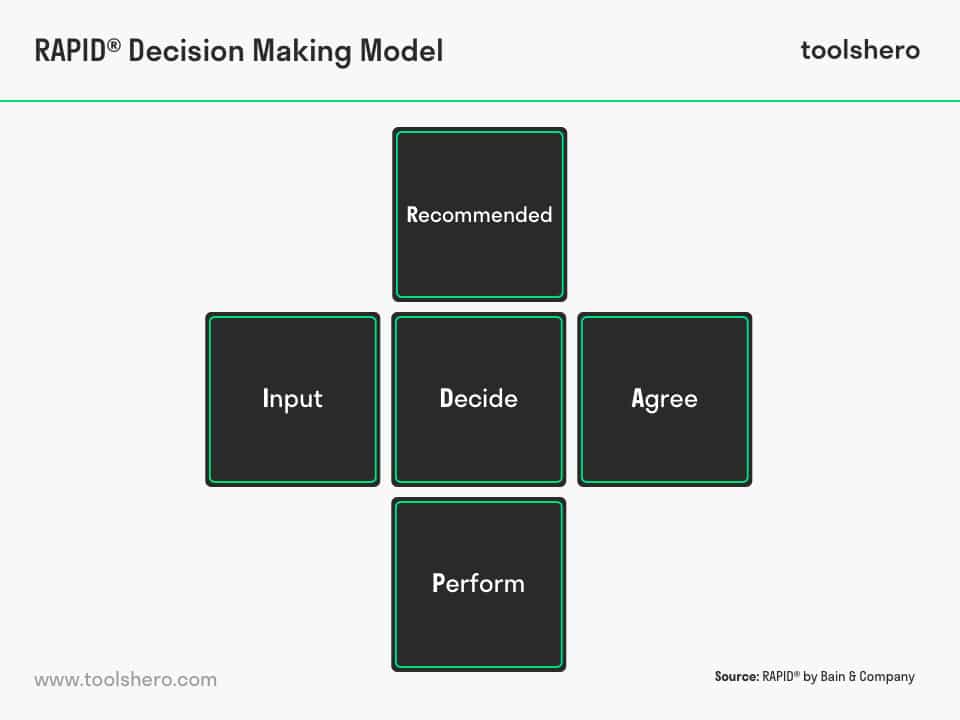RAPID Decision Making Model

RAPID Decision Making Model: this article describes the concept of the RAPID Decision Making Model, developed by Bain & Company in a practical way. After reading you will understand the basics of this powerful decision making tool.
What is the RAPID Decision Making Model?
The decision-making process is an important foundation for any organisation, regardless of its size and complexity. Employees make decisions on a strategical, tactical (department) and operational level. Strategic decisions are made for the long term, tactical decisions for the medium term and operational decisions are made for the short term or on an every-day basis. All are about making decisions.
Making decisions can be difficult and leads to overthinking. The Bain’s RAPID Decision Making Model can help. This is a registered trademark developed by the American management consulting form Bain & Company.
Support of Bain’s RAPID Decision Making Model
The Bain’s RAPID Decision Making Model helps managers find out which activities are required to come to the right decisions.
It also promotes employee participation. If none of an organisation’s employees really understand where their responsibility begins and where it ends, it will be difficult for everyone to agree on a decision.
Decisions can also be complex or communicated poorly to the team. Without adequate support from everyone, results from a decision will never be as good as from a decision that was made with the participation of the people affected by it. Not consulting employees on a decision can lead to unhappy people not motivated to properly carry it out.
Acronym
The Bain’s RAPID Decision Making Model is an acronym. It stands for Recommend – Agree – Perform – Input – Decide.
Below you will find a brief explanation for each element:
Recommend
This is about giving all employees within an organisation the opportunity to give proposals and/or recommendations. They provide input and can add information that becomes part of the decision-making process. It is the manager’s responsibility to consult every team member, which allows for effective and efficient decision-making. Every employee should be given insight into the process, and the manager should make clear in which aspects they will and will not be involved.
Agree
First of all, the group of employees should agree to the proposals that were presented by others. They can change the negotiations and/or talk to the people in charge. Secondly, this part asks different stakeholders, including customers, suppliers, employees and other departments’ managers to give their opinion. A good decision can be made when everyone has given their approval.
Perform
An individual or a group of employees is accountable for the execution of the process. This is a testing phase, carried out by key figures who have the right knowledge, expertise and experience. They are asked to carefully analyse the process, report on it and discuss the proposed decisions with each other.
Input
This group of employees will communicate information and facts about the process to other employees and helps generate support for the decision within the organisation. This ensures that the proposals are viable and remain sustainable. When everything about the process is clear and has been communicated to all employees, it is more likely that the final decision can be implemented quickly and successfully.
Decide
The person or small group of people who makes the final decision and is responsible for its implementation. They have the ability to resolve uncontested matters and make final changes. If there is resistance from employees, they are responsible to confront the employees with the fact that they have already agreed to the decision at an earlier stage.
Motivating
In practice, those involved can be assigned more than one of the RAPID framework letters and they can also be given ownership of certain sub-activities.
The Bain’s RAPID Decision Making Model can be used in all layers of an organisation, or be used as a tool for a problem within a department. The bigger an organisation, the more management layers and people are involved with making decisions. When so many people get involved, this can lead to confusion and frustration. Despite everyone’s best intentions, problems are likely to arise and it will often be difficult to reach a consensus. At worst, such decision-making problems can even lead to mistrust and reduced motivation.
The Bain’s RAPID Decision Making Model makes the decision-making process easier and it helps motivate employees. It forces everyone to identify the different activities that precede a decision.
Advantages of the Bain’s RAPID Decision Making Model
The Bain’s RAPID Decision Making Model has several advantages. It can help people deliberate a decision carefully before making it. The right employees are given responsibility, distributing power more evenly. Employees respond with more loyalty to the decisions and will work harder to ensure a successful result.
It also makes it clearer who actually is involved in making the decision. Employees, customers and suppliers all like to know how the decision-making process was established. This makes them feel more involved and understand better what previously might have been very unclear to them.
The Bain’s RAPID Decision Making Model also helps organisations to achieve their objectives more efficiently and effectively, because everyone is given the opportunity to contribute to the decision-making process.
Bain’s RAPID Decision Making Model and Responsibility
High-quality decision-making and strong performance go hand-in-hand. Still, in many companies even clear, well-framed decisions can be thwarted by uncertainty and a lack of clarity as to who is responsible.
The Bain’s RAPID Decision Making Model is a tool that can help clarify who is responsible for a decision. It assigns ownership of five key roles in any decision. Clearly defining these roles helps teams in an organisation to be better able to quickly and effectively make the right choices.
The Bain’s RAPID Decision Making Model is not a communication method, rather it is simple a way to diagnose and prescribe the best way to make a decision together. However, it does require practice and discipline.
It’s Your Turn
What do you think? Is the Bain’s RAPID Decision Making Model applicable in today’s modern business and personal challenges? Do you recognize the practical explanation or do you have more suggestions? What are your success factors for a good decision making process?
Share your experience and knowledge in the comments box below.
More information
- Bain & Company (2011). RAPID®: Bain’s tool to clarify decision accountability. Retrieved 25/07/2017 from: https://www.bain.com/publications/articles/RAPID-tool-to-clarify-decision-accountability.aspx
- Blenko, M. W., Mankins, M. C., & Rogers, P. (2010). Decide and deliver: 5 steps to breakthrough performance in your organization. Harvard Business Press.
- Rogers, P., & Blenko, M. (2006). Who has the D?. Harvard Business Review, 84(1), 52-61.
How to cite this article:
Mulder, P. (2017). RAPID Decision Making Model. Retrieved [insert date] from ToolsHero: https://www.toolshero.com/decision-making/rapid-decision-making-model/
Add a link to this page on your website:
<a href=”https://www.toolshero.com/decision-making/rapid-decision-making-model/”>ToolsHero: RAPID Decision Making Model</a>
Published on: 25/07/2017 | Last update: 03/03/2022














8 responses to “RAPID Decision Making Model”
This is not an accurate description of Bain’s RAPID Decision Model. Almost none of the descriptions of the five elements are correct, in short:
Recommend – Only one person can make a recommendation. Committees don’t make recommendations.
Agree – This role is rarely used. Typically the Agree role goes to a group like Law, Compliance or even IT. The Agree should agree to the recommendation. If the agree role does not agree, then the recommend role must present the ‘disagreement’ as part of the recommendation along with the risk mitigation plan. If the Decider role accepts a recommendation with a disagreement, the Decider is explicitly taking accountability for negative consequences of going forward.
Perform – this is correct in the article
Input – This role is not responsible for communicating the decision to the organization — people providing input are providing information to the recommend role. This should be a limited audience — it doesn’t help decision making in terms of Quality, Yield, Speed or Accuracy to have a huge number of inputers. The Recommender doesn’t need to agree with all of the input nor has to share the perspectives of the inputers with the decision maker — this last point is a key difference between Input and Agree.
Decide – Only one decision maker. Committees don’t make decisions. There must be a single point of accountability for the decision.
Dear mr. Pederson, Thank you for your comment. There are multiple interpretations for applying this model. Your additional information is more than welcome. However, we do not edit our posted articles. Kind regards, Vincent
Thanks for the clarification
Good for Team involvement before implementing a change of process.
Thank you for your comment, Suman.
I am proud of this process
Does one need to be trained/certified to use this model?
Hi Ann, thank you for your comment. You don’t need training to use this model. You can use it in practice and we are developing a template for using this method.